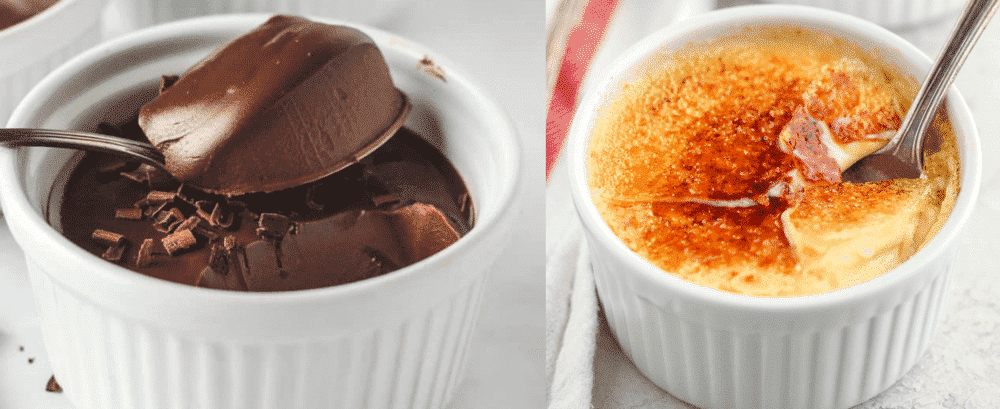
Dessert is one of the blessings we all should be grateful for (people with a sweet tooth would relate to it). With this being said, there are hundreds of desserts available, and it becomes hard to choose that one creamy and equally sweet dessert.
Likewise, people with a sweet tooth would know about Pot de Crème Vs. Crème Brulee, but they don’t know the difference. So, let’s see what the differences are!
Pot De Creme vs Creme Brulee
Pot De Crème
We all have snacked on the instant custard, but Pot de crème is the “fancy” dessert custards of the French origin. This custard variant goes back to the 17th century and is commonly known as the pot of cream and pot of custard. It wouldn’t be wrong to say that pot de crème is the classic French dessert, which usually has chocolate. However, there are other flavors available as well, such as caramel. Pot de crème is made with part milk and heavy cream parts.
As a result, the dairy version of pot de crème feels lighter as compared to the chocolate version. However, many people say that chocolate is the shining factor. When it comes down to making pot de crème, chefs can use the small ramekin. However, there are specialized pots for making pot de crème as they come with their own lid. The lids will help protect the custard for baking purposes, promising a smooth and consistent texture.
Pot de crème is famous for the creamy texture, and the flavor is pretty intense. The best thing about pot de crème is that it’s a convenient dessert. To be honest, the luscious taste is what makes it the “the” pot de crème. For instance, the undercooked pot de crème might be tasty, but the runny texture will be there. Likewise, overcooking will lead to a grainy texture. When it comes down to making pot de crème, the perfect consistency and texture are established through gentle yet thorough whisking.
Some people use the preheated ovens for making pot de crème, but if you are making it on the stovetop, don’t go beyond 170-degrees Fahrenheit since gentle cooking is the key. When it comes down to serving, there are various options out there. For instance, there are neat custard cups, but you can even opt for teacups and coffee cups (it’s about the presentation and decoration with pot de crème). As for cooking, there are various utensils.
For instance, the pots with lids can be found through antique stores. However, modern designs are much bigger, making it easier to play around with the presentation. All in all, pot de crème is a baked custard with a very light feel. Earlier, there was only vanilla flavor, but the modern recipes have made coffee, caramel, and pumpkin flavors as well.
Crème Brulee
To be honest, whenever we talk about pot de crème, there is always a notion about crème Brulee because it’s one of the most famous French desserts. Crème Brulee is also named the burnt cream or Trinity cream. Generally, crème Brulee is made by cooking the rich custard base, and on the top, the caramelized sugar is added (hardened one). As for the serving, crème Brulee is usually chilled, and the heat from caramelized sugar warms up the top.
However, the center remains cool and chilled. The traditional recipe (French one, you know) has the vanilla custard base, but the chefs are always experimenting with flavors. On the top, some chefs tend to add fruits as well. If we look back, crème Brulee has been a part of French cuisine since 1691 (yes, it’s the centuries-old French recipe, pretty classic). As far as the serving is concerned, it uses ramekins while the caramel discs added on the top (at the time of serving).
On the contrary, some chefs make the caramel disc directly on the top. As far as cooking techniques are concerned for the custard (or crème as the French people say), there are two techniques. Firstly, there is a hot custard where everything is cooked on the heat. On the other hand, the cold custard is made by the bain-marie baking process. If the latter technique is being used, the batter is poured into the ramekins and then put for baking.